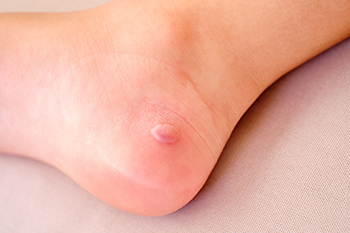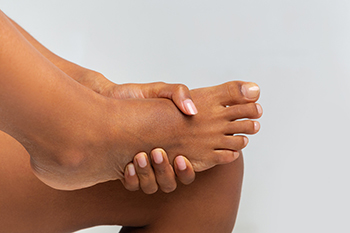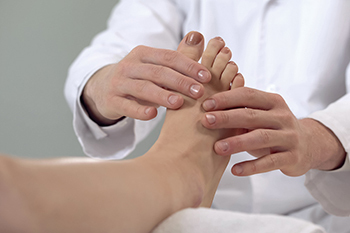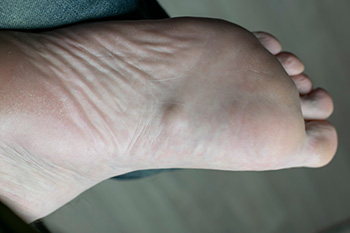Items filtered by date: July 2025
What You Need to Know About Diabetic Blisters on the Feet

Diabetic blisters are rare but serious skin complications that can appear on the feet of people with diabetes. These blisters can form without injury and are often linked to poor blood sugar control and nerve damage, called neuropathy. They typically appear suddenly as fluid-filled sacs on the toes, heels, or soles. While they are usually painless, the skin around them may feel tight or itchy. Left untreated, they can become infected and lead to more serious complications. A podiatrist can evaluate the blister, ensure it is healing properly, and help prevent infection. Treatment usually includes protecting the area with sterile dressings, managing blood sugar levels, and checking for signs of infection. Regular foot care is essential for people with diabetes to prevent further problems. If you are dealing with this issue, it is suggested that you make an appointment with a podiatrist.
Blisters are prone to making everyday activities extremely uncomfortable. If your feet are hurting, contact Mindy J. Trotter, DPM, CWSP of Georgia. Our doctor can provide the care you need to keep you pain-free and on your feet.
Foot Blisters
Foot blisters develop as a result of constantly wearing tight or ill-fitting footwear. This happens due to the constant rubbing from the shoe, which can often lead to pain.
What Are Foot Blisters?
A foot blister is a small fluid-filled pocket that forms on the upper-most layer of the skin. Blisters are filled with clear fluid and can lead to blood drainage or pus if the area becomes infected.
How Do Blisters Form?
Blisters on the feet are often the result of constant friction of skin and material, usually by shoe rubbing. Walking in sandals, boots, or shoes that don’t fit properly for long periods of time can result in a blister. Having consistent foot moisture and humidity can easily lead to blister formation.
Prevention & Treatment
It is important to properly care for the affected area in order to prevent infection and ease the pain. Do not lance the blister and use a Band-Aid to provide pain relief. Also, be sure to keep your feet dry and wear proper fitting shoes. If you see blood or pus in a blister, seek assistance from a podiatrist.
If you have any questions, please feel free to contact our office located in Peachtree City and Newnan, GA . We offer the newest diagnostic and treatment technologies for all your foot care needs.
What Can Cause Pain on the Outside of the Foot

Pain along the outer edge of the foot, also known as lateral foot pain, can result from a number of conditions. It may develop suddenly after an injury or gradually over time due to overuse or poor foot mechanics. Common causes include stress fractures, peroneal tendonitis, ankle sprains, and conditions like cuboid syndrome or arthritis. People with high arches or those who wear unsupportive footwear may be more prone to discomfort in this area. Symptoms can include aching, sharp pain, swelling, or instability during movement. Treatment depends on the cause but often includes rest, footwear changes, targeted exercises, or custom orthotics to improve alignment and reduce pressure. In some cases, imaging or further testing may be needed to confirm the diagnosis. If pain on the outside of your foot is interfering with your routine or is worsening, it is suggested that you consult a podiatrist for an accurate diagnosis and appropriate treatment.
Foot Pain
Foot pain can be extremely painful and debilitating. If you have a foot pain, consult with Mindy J. Trotter, DPM, CWSP from Georgia. Our doctor will assess your condition and provide you with quality foot and ankle treatment.
Causes
Foot pain is a very broad condition that could be caused by one or more ailments. The most common include:
- Bunions
- Hammertoes
- Plantar Fasciitis
- Bone Spurs
- Corns
- Tarsal Tunnel Syndrome
- Ingrown Toenails
- Arthritis (such as Gout, Rheumatoid, and Osteoarthritis)
- Flat Feet
- Injury (from stress fractures, broken toe, foot, ankle, Achilles tendon ruptures, and sprains)
- And more
Diagnosis
To figure out the cause of foot pain, podiatrists utilize several different methods. This can range from simple visual inspections and sensation tests to X-rays and MRI scans. Prior medical history, family medical history, and any recent physical traumatic events will all be taken into consideration for a proper diagnosis.
Treatment
Treatment depends upon the cause of the foot pain. Whether it is resting, staying off the foot, or having surgery; podiatrists have a number of treatment options available for foot pain.
If you have any questions, please feel free to contact our office located in Peachtree City and Newnan, GA . We offer the newest diagnostic and treatment technologies for all your foot care needs.
Struggling with Diabetic Foot Ulcers?

By offering treatments such as Hyperbaric Oxygen Therapy, Debridement, Offloading, Specialty Dressings, and more, we provide not just hope but a comprehensive approach to healing for those suffering from non-healing foot and leg wounds.
See if advanced wound care is right for you - Request an appointment today!
How Gout Differs in Women and Men

Gout is a type of inflammatory arthritis caused by a buildup of uric acid crystals in the joints, leading to sudden pain, redness, and swelling. While it is more common in men, women can develop gout later in life, often after menopause when hormonal changes reduce the protective effect of estrogen. While gout predominantly affects the big toe in both women and men, women may also experience gout in the knees, wrists, fingers, and ankles. Symptoms can also be less intense among women at first making diagnosis harder. A podiatrist can evaluate joint pain, confirm a diagnosis, and recommend lifestyle changes and treatment. If you have symptoms of gout, it is suggested that you consult a podiatrist to help you manage this painful condition.
Gout is a foot condition that requires certain treatment and care. If you are seeking treatment, contact Mindy J. Trotter, DPM, CWSP from Georgia. Our doctor will treat your foot and ankle needs.
What Is Gout?
Gout is a type of arthritis caused by a buildup of uric acid in the bloodstream. It often develops in the foot, especially the big toe area, although it can manifest in other parts of the body as well. Gout can make walking and standing very painful and is especially common in diabetics and the obese.
People typically get gout because of a poor diet. Genetic predisposition is also a factor. The children of parents who have had gout frequently have a chance of developing it themselves.
Gout can easily be identified by redness and inflammation of the big toe and the surrounding areas of the foot. Other symptoms include extreme fatigue, joint pain, and running high fevers. Sometimes corticosteroid drugs can be prescribed to treat gout, but the best way to combat this disease is to get more exercise and eat a better diet.
If you have any questions please feel free to contact our office located in Peachtree City and Newnan, GA . We offer the newest diagnostic and treatment technologies for all your foot and ankle needs.
What You Need to Know About Plantar Fibromas

A plantar fibroma is a firm, noncancerous growth that develops within the arch of the foot in the plantar fascia tissue. It can cause discomfort or pain, especially when walking or standing. The exact cause is unknown, but it may be linked to genetics, foot trauma, or medical conditions, such as diabetes and epilepsy. Symptoms include a noticeable lump in the arch, tenderness, or a feeling of pressure when wearing shoes. Risk factors include repetitive foot strain and certain health conditions. A podiatrist can diagnose a plantar fibroma through examination and imaging, then provide treatment options such as orthotics. If you notice a lump in the arch of your foot, it is suggested that you schedule an appointment with a podiatrist for appropriate treatment solutions.
A plantar fibroma may disrupt your daily activities. If you have any concerns, contact Mindy J. Trotter, DPM, CWSP of Georgia. Our doctor can provide the care you need to keep you pain-free and on your feet.
Plantar Fibroma
A plantar fibroma is a fibrous knot in the arch of the foot. It is embedded in the plantar fascia which is a band of tissue that extends from the heel to the toes along the bottom of the foot. There can be multiple plantar fibromas in the feet at the same time. There are no known causes for this condition. If you have a plantar fibroma, there will be a bump in the arch of your foot that cannot be missed. Any associated pain is most often due to a shoe rubbing against the nodule. Non-surgical options, such as steroid injections, physical therapy, and orthotics should be tried first. Surgery is a last resort and is the only thing that will remove a plantar fibroma entirely. Consult with a podiatrist for a proper diagnosis and to determine the treatment regimen that is right for you.
What Causes a Plantar Fibroma?
While there are no specific causes identified, a plantar fibroma can possibly come from genetic predisposition or the formation of scar tissue that forms from healing the tears in the plantar fascia.
What Are the Symptoms of a Plantar Fibroma?
There will be a noticeable lump in the arch of the foot that may or may not cause pain. If pain is felt, it is typically because a shoe is rubbing up against the lump or when walking or standing barefoot.
Treatment and Prevention
A plantar fibroma will not disappear without treatment, but it can get smaller and be a non-issue. If pain persists, a podiatrist examines the foot and when the arch of the foot is pressed, pain can be felt down to the toes. An MRI or biopsy might be performed to help diagnose or evaluate the plantar fibroma. The following non-surgical options are generally enough to reduce the size and pain of these nodules:
- Steroid injections
- Orthotics
- Physical therapy to help apply anti-inflammatory creams on the bump
Surgery is considered if the mass increases in size and the patient continues to feel pain after non-surgical methods are tried.
If you have any questions please feel free to contact our office located in Peachtree City and Newnan, GA . We offer the newest diagnostic tools and technology to treat your foot and ankle needs.
Hammertoe Surgery and Its Effect On Balance

Some people worry that correcting a hammertoe might interfere with their balance, but this is not typically the case. Hammertoe surgery is designed to straighten a bent toe that no longer functions properly. Since balance relies more on the heel, the ball of the foot, and strong ankle support, realigning a toe does not usually disrupt stability. In fact, removing the pain and pressure caused by a deformed toe can improve how the foot makes contact with the ground. After healing, most people notice improved comfort in shoes and a more natural walking pattern. Targeted exercises may also help restore strength and coordination following surgery. If you are concerned about changes in your gait or posture after toe correction, it is suggested that you consult a podiatrist for guidance tailored to your needs.
Foot surgery is sometimes necessary to treat a foot ailment. To learn more, contact Mindy J. Trotter, DPM, CWSP of Georgia. Our doctor will assist you with all of your foot and ankle needs.
When Is Surgery Necessary?
Foot and ankle surgery is generally reserved for cases in which less invasive, conservative procedures have failed to alleviate the problem. Some of the cases in which surgery may be necessary include:
- Removing foot deformities like bunions and bone spurs
- Severe arthritis that has caused bone issues
- Cosmetic reconstruction
What Types of Surgery Are There?
The type of surgery you receive will depend on the nature of the problem you have. Some of the possible surgeries include:
- Bunionectomy for painful bunions
- Surgical fusion for realignment of bones
- Neuropathy decompression surgery to treat nerve damage
Benefits of Surgery
Although surgery is usually a last resort, it can provide more complete pain relief compared to non-surgical methods and may allow you to finally resume full activity.
Surgical techniques have also become increasingly sophisticated. Techniques like endoscopic surgery allow for smaller incisions and faster recovery times.
If you have any questions please feel free to contact our office located in Peachtree City and Newnan, GA . We offer the newest diagnostic and treatment technologies for all your foot and ankle needs.
